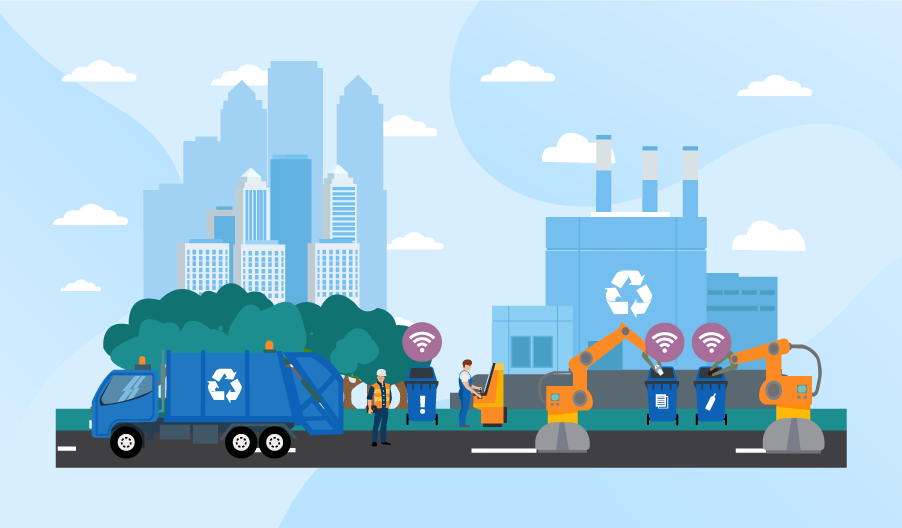Al-Based Technologies for Fighting Environmental Issues
Artificial neural networks (NN), the Internet of things (IoT) and intelligent custom software solutions work for the good of humanity solving global problems. One of such problems is waste management. There are traditional methods, e.g., manual garbage sorting at plants, that help fight that rampant problem, but they appear to be insufficient. According to “The World Counts” statistics, the amount of rubbish is growing year by year as well expenses on its collection, transportation, and recycling.
State authorities and people in charge can find a solution to the waste management issue in popular technological trends. Fortunately, there are some cases of successful artificial intelligence application to rubbish collection and sorting to draw inspiration from.

Monitoring trash in real time and HD (it’s not a joke)
What happens when dumpsters meet IoT? In this case, the waste collection becomes a way cheaper and easier. A startup from San Francisco Compology created WasteOS and equipped garbage cans with sensors and video cameras to monitor fullness. High-resolution images of containers’ inside can be any time accessed by people who are in charge of the waste collection via a mobile application. Smart dumpsters are also equipped with GPS to track their location and movement. All the related data are gathered and processed by the IoT cloud-based platform.
Garbage truck drivers don’t have to serve half-empty containers. They can use tablets to find the dumpsters 100% filled with waste and the best route to reach them. Functioning of such garbage management system allows considerable budget savings. In such a way, WasteOS allows authorities to reduce the costs of waste collection by 40%.
A similar waste management system is widely used in Finland. Finnish company Enevo made the research and claimed that garbage trucks drove to containers filled only by 30-60 percent. Local authorities were forced to recognize that the current approach to waste collection is, as ironically as it sounds, a waste of money. Enevo has solved the problem: their smart dumpsters collect data about container fullness and send them to the cloud. The system also provides tips about some effective ways of waste collection, reports the number of available trucks and analyzes traffic. Besides, it helps reduce the number of garbage trucks on the streets and, as a consequence, carbon dioxide emissions.
Spain, Great Britain, and Poland also introduce smart waste management systems. Polish engineers call their smart dumpster Bin-e. It differs from other dumpsters of the kind. Bin-e doesn’t only help monitor the container fullness but also assists in sorting rubbish. The system scans the barcode, if there is any, on a thrown away item, identifies the type of waste and moves it to an appropriate section. Unfortunately, the system can’t sort rubbish that doesn’t have a barcode. Polish containers also press rubbish for saving space so that they could accommodate more waste.
Can artificial neural networks help accelerate the process of waste segregation?
Artificial neural networks have become a trend during the recent years, but their options are still limited. It’s a proven fact that this technology is great for processing images taken by smartphones, but it still can’t be used in some domains requiring higher safety and 100 % accuracy. As of today, Al can be widely applied in the fields where a high level of accuracy isn’t required, e.g., for identifying recyclable materials at plants. There are cases proving that the application of artificial NN to waste sorting is a good project for investment.
A Finnish company ZenRobotics first created robots for sorting recyclables in 2011. The winning combination of artificial intelligence and green philosophy helped the Finns to develop a smart solution. Their robot is able to pick rubbish from the conveyor belt and sort it by type. Al doesn’t only allow the ZenRobotics system to identify valuable materials that can be recycled but also controls robotic arms. Their motion adapts to a situation. There is also no need to worry about the working speed of such machines. The latest robot by ZenRobotics is able to do 4000 picks an hour.
Sorting plastic by type
Automated waste sorting is a realistic task with the assistance of Al. There are other challenges that waste management faces, and Al is ready to take them up, e.g., identification and sorting of different types of plastics. There are some experiments regarding this issue, but there are still no effective solutions to be widely used on an industrial scale.
Plastic pollution is the most dangerous one. People dump around 275 mln tons of plastics annually, and only 5 percent of this amount is reused. Plastic bottles, containers, etc. are made from different types of polymers that can be recycled only separately. These polymers are usually manually sorted at the plant.
This issue can be handled by a combination of spectroscopy and neural network data analysis. The effectiveness of the method is proved for sorting several types of plastics, and the number of these polymers can be extended thanks to the flexibility of NN.
Takeaways
The combination of smart technologies and green philosophy is advantageous for humanity. The solutions for waste management mentioned in this article allow cutting down expenses on collecting waste almost in half. Reduction of exhaust fumes thanks to fewer garbage trucks trips in the cities is another benefit. Effective trash sorting facilitates and accelerates the process of recycling. As a result, the recycled waste gains a second life and is used for good. Relying on technological trends in environmental matters helps make our world a better place.

